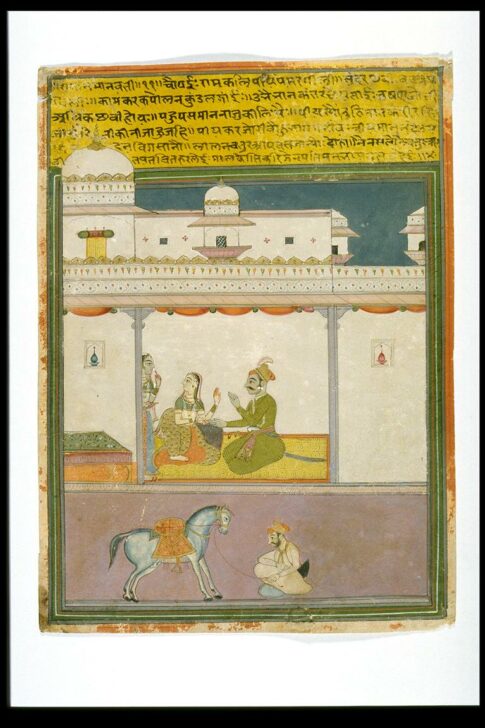Ragamala series: Ragini Minavati
Artist Unknown, India, Rajasthan, Jaipur School

Description
Subject Matter:
Ragamala paintings draw from aspects of human experience in order to visualize specific moods, emotions, and qualities such as love, anguish, valor, weakness, and strength. A raga in Indian music is a melody consisting of a string of notes in a particular arrangement. Raginis are derivations from or variations of ragas in feminine mode (the basis of these classifications remains unexplained in many cases), and could have different or similar musical structures as ragas. Specific ragas are associated with specific times of the day, seasons, and emotions. When visualized, as here, ragas and raginis are meant to evoke the same affective responses that are allied to their musical modes. The text above the illustration refers to stories or incidents associated with the depicted raga/ ragini, but may not necessarily be narrative-like or descriptive. Drawn from literary tropes and tales that sophisticated writers and viewers would be aware of, the inscriptions are an integral part of the overall experience of this miniature painting. An illiterate viewer, however, could still enjoy the scene without reading the text.
Another name for Ramkali Ragini, Minavati is a morning melody. In this image, a beautiful woman looks away from her lover, a sign of her being offended and cross. He tries to assuage her, but to no avail. The romantic tension between the lovers is symbolized in their gestures and her stare away from him, and towards her attendant.
Physical Description:
A lady and her lover are shown in the center-left of the scene, holding hands and gesturing. An attendant appears behind the lady, and the two turn to look at her. A male attendant, along with a horse, is shonw in the bottom register, separated from the precincts of the palace where the main scene takes place.
Usage Rights:
If you are interested in using an image for a publication, please visit https://umma.umich.edu/request-image/ for more information and to fill out the online Image Rights and Reproductions Request Form.